




SKY S. TERRONES
Nicole Adams has a Chartered Professional Accountant (CPA) designation and is the chief financial officer (CFO) at UFV.
The 2025/2026 Consolidated Budget Plan is out, amid concerns of student fee increases and potential lay-offs in light of the international student cap imposed by the Canadian government. The Cascade approached CFO Nicole Adams to ask about the challenges and future planning regarding the new budget.
This fiscal year, UFV is looking at around a $5 million increase on both the revenue and expense sides, with most of it related to the new student housing. However, with the ongoing complications from the government reducing international student enrollment, Adams explained that UFV also considered the current environment.
This year’s evaluation includes the changes imposed by the Immigration, Refugees and Citizenship Canada (IRCC) regarding the 10 per cent decrease from the limit set for 2024 — a situation that has created concern and difficulties throughout Canada — as well as the U.S. tariff threats.
“When we do our budgeting, we take those current situations into effect, then we plan accordingly. So, yes, there are concerns across Canada … There are several institutions that are, even this current fiscal year, struggling to meet a balanced position at the end of Mar. 31, 2025.”
Despite these struggles, UFV has maintained the previous year’s number of
900 new international students enrolled. Adams shared that program reviews and building contingencies into the budget to mitigate risk helped keep them afloat. She praised the collaborative work from the UFV community, which not only helped them through these challenges but also got them through the COVID-19 pandemic without a deficit.
“UFV has made very good strategic decisions in the past, and those decisions have helped us build a position of financial sustainability.”
On Mar. 10, 2025, the Kwantlen Polytechnic University (KPU) handed out termination notices to around 70 faculty members due to the decline in international registration. When asked about the possibility of this happening at UFV, Adams reassured that there are no budgeted lay-offs of permanent employees in the current consolidated budget and that taking that measure would require many steps before considering it.
“It would not be something that would be taken lightly … A lot of consultation and discussions would have to, or would happen, before we would move forward with that, and we do have processes. I mean, obviously, we have a union and a collective bargaining agreement. So, there is language and processes in there that as a university we do have to follow … We have to take that into consideration as well whenever any of those decisions [are] even discussed.”
Regarding the tariffs, Adams said that their procurement team has been diligently staying up to date with how the tariffs may impact UFV. When someone needs to order items, the team explores

Canadian options first. She emphasizes that buying Canadian isn’t always viable, but their proactive attitude shows collaboration and a collective effort to support each other, not only in the economic aspect.
“If there’s any way for us to decrease the effect or reduce, whether financial or other[wise] … then that’s what I think everybody is very much on board [of] trying to do as well.”
Adams also commented that every time a surplus is achieved, it goes to the debt and is reinvested to fund things that will improve the university. Many decisions are rooted in UFV’s Budget Planning Principles, and one of them is transparency, which is why anyone can access the budget documents via the UFV website.
However, when The Cascade approached UFV International to ask about tuition fees, they had no comments on the matter. Instead, they were redirected
to the Director of Communications, Jeboah M. Godron, who did not get back to the paper.
While the budget does not explicitly state a specific percentage increase for tuition fees, Adams’ optimistic view and carefully balanced budget crafted by the financial team leave little room for adjustment. Moving forward, preparations for the 2026/27 years have already begun. Adams has just marked 20 years of working at UFV and reminisced about what motivates her when facing the trials of the job.
“I’ve been here for a while. So, I guess that says a lot about how much I enjoy working here and the people … and there are always interesting things that are occurring, some more challenging than others, but I like a challenge, and I care about UFV, and so that is what motivates me.”
Despite the removal of carbon pricing, Canada still continues to struggle
GAURI SETHI
Dr. Michael Batu is an economist and associate professor of Economics at the University of the Fraser Valley.
On his first day, Prime Minister Mark Carney signed an order to remove the federal carbon tax, which came into effect on Apr. 1. Since 2008, the carbon tax has increased what British Columbians paid on natural gas and gasoline. Professor Michael Batu spoke to The Cascade about the carbon tax removal and the economic
and environmental effects this has on Canada.
Batu said that with the removal of the carbon tax, there will be consumers who will profit greatly from the reduced prices.
“The consumers will benefit because right away, they will see a decrease in the price of petroleum products. So, that will immediately affect consumers, especially those who commute [and] drive long distances.”
Originally, the carbon tax was projected to rise annually. In 2019, the cost for a
tonne of carbon was $20; by 2030, this price was expected to rise to $170 per tonne. According to CBC News, after the carbon tax was lifted, the price of gas and gasoline also increased:
“As of March 31, when it ended, it added 17.6 cents a litre to gasoline and 15.25 cents per cubic metre to natural gas.”
However, Batu also underlined that removing the rebate associated with the carbon tax — a tax-free payment to residents intended to offset the costs of carbon pricing — could be a problem for
low-income households.
“If you’re in the upper income brackets, you don’t receive the rebates at all. Rebates usually go to the individuals who are the lower income. So if you’re lower income, you would be hit hard by the elimination of the carbon tax, because you don’t get the rebate.”
He explained that the idea behind implementing the carbon tax was to encourage people to use less emissions.
CONTINUED FROM PAGE 04
“One feature of the carbon tax is that the government collects taxes from certain groups of people, and then it transfers some of it to folks who are in the lower part of the income [bracket] … it’s a form of income transfer, but also part of it is to change behaviour, because the idea is that if the price of oil is expensive, we will drive less.”
Batu mentioned that the government’s hope was to reduce pollution for future generations by taxing fuel and other carbon-emitting products so that people would adopt more eco-friendly lifestyles. However, the impact grew less evident with time.
Furthermore, Batu explained how the long-term data in British Columbia did not show any drastic reduction in carbon emissions over the years — but it did show an increase.
“[From] the latest data that we had, the
greenhouse gas emissions were more than what we had in 2008.”
He said that the ultimate objective is to lower our carbon footprint while balancing affordability and accountability. Batu believes that future-oriented policies strike a better balance than completely removing carbon pricing.
Additionally, Batu stressed that shortterm savings should not come at the expense of environmental responsibility, especially when future generations will feel the impact.
“We have to be responsible stewards of the environment because it’s not we who are going to suffer. It’s going to be the future generation. So, we need to come up with an equitable and fair mechanism so that it’s not as hurtful to us at the present as well as to the future.”
Batu explained that even if people want to go green, they do not always have the means or resources to do so, making the entire process slower than expected. The

cost is just one of the multiple challenges; infrastructure is another major issue. Gas stations far outnumber charging stations, and bike lanes are limited and unsafe in
GAURI SETHI
In today’s fast-paced digital world, it is challenging for businesses to become successful. UFV alumnus Keenan Beavis, founder of Longhouse Branding & Marketing, is helping businesses do just that. His company offers customized marketing strategies for businesses, so
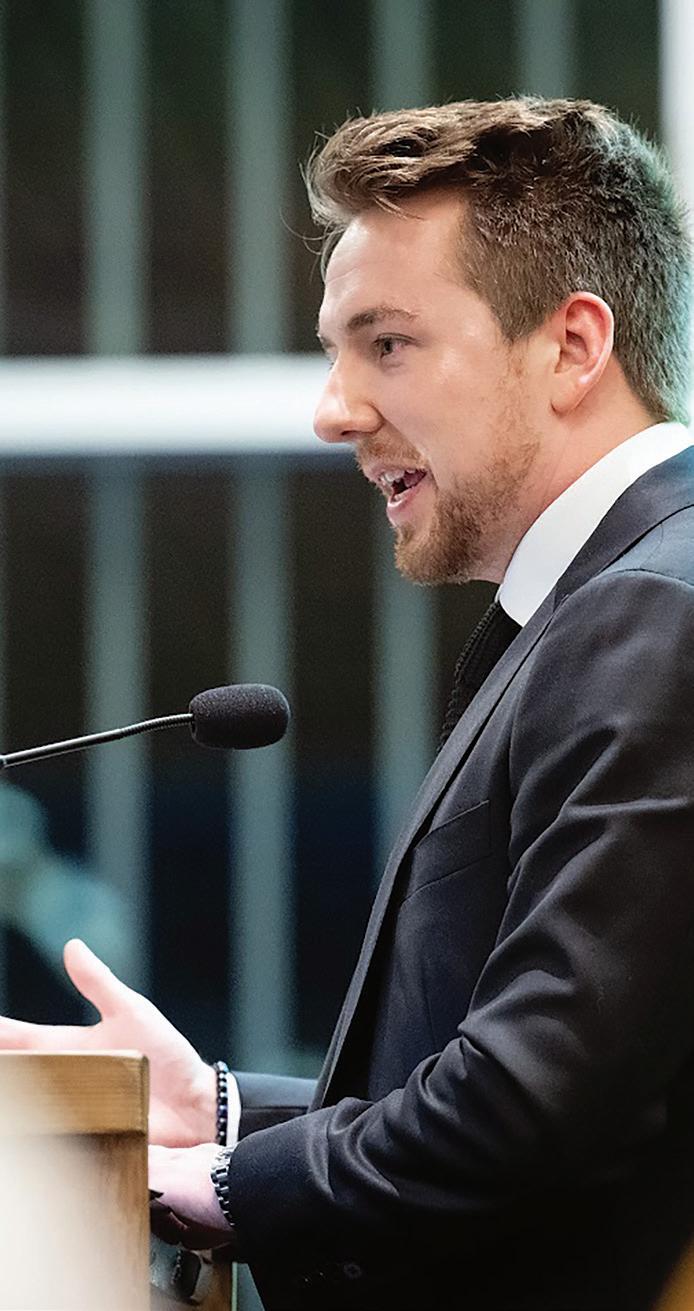
Photo by Alessio Zaccaria
that they can concentrate on their main focus. Thus far, over 800 businesses have benefited from what Longhouse Branding & Marketing has to offer.
“We dedicate time to the branding and marketing projects that are on their to-do list, so that they can win their time back, and then these busy leaders can focus on what actually needs them the most in their business.”
Several years before Longhouse Branding & Marketing, Beavis was merely a teenager creating video content on YouTube, such as parodies of Katy Perry songs. However, what began as a means to increase viewership evolved into a deeper understanding of digital marketing. This helped struggling and small businesses double their consumer base and achieve success, earning Beavis the 2025 Young Indigenous Entrepreneur award.
Beavis recalled that when he was around 12 or 13, he learned how to utilize Search Engine Optimization (SEO), which ranks internet search results using algorithms. He highlighted his goal of attracting a large audience to his video content on YouTube, using this strategy to help market himself.
“I dedicated a lot of time to learning how to do that very early on, and I got to the 27th most viewed [channel] in Canada.”
While the competition grew on YouTube, Beavis had the opportunity to visit the 2013 FAN EXPO in Vancouver.
However, his social anxiety kept him from fully participating. This led him to launch an online fan T-shirt merch business called Pokéshop, which taught him how to advertise efficiently.
When asked about his journey to becoming an entrepreneur, he reflected on how his business taught him the true value of every dollar spent on advertising.
“What marketing does is it gets the word out about really great products that add value to their lives.”
Beavis further emphasized how using SEO and creating content on YouTube helped him realize his talent. His entrepreneurial journey took a significant turn when he helped his jiu-jitsu instructor, Marcus Soares, revive his business — Marcus Soares Brazilian Jiu-Jitsu — with his marketing knowledge.
He explained that after doing some advertising, SEO, and redoing their website, there was a progressive increase in the number of jiu-jitsu students enrolling in his programs.
“The size of the school doubled in six months and that showed me that there are talented business owners who just don’t have the time, or they don’t have the time to learn this new skill of digital marketing.”
Beavis also highlighted how jiu-jitsu had a significant impact on him, which is constantly reflected in how he runs Longhouse Branding & Marketing.
“One of our core principles at Longhouse is to be a teacher that extends
most cities. The shift to a greener economy will remain difficult if there are no easily accessible alternatives to gas-powered vehicles, particularly for lower-income Canadians.
“These carbon taxes are just temporary. You need to have another track here, where you have the permanent solutions. Those, like I mentioned, infrastructure for green technologies you subsidize, especially for poor people … That’s what these policies are right now. They’re not lowering gas emissions because we’re so focused on the temporary solutions, we’re barely scraping the surface of the permanent solution.”
Batu concluded by emphasizing the importance for people to take care of the environment and the earth.
“We have to do our share to be sustainable, you know, because this is the only home that we have.”
Interviews have been edited for length and clarity.
to our team, to our partners, which is our term for our clients, and it’s for anyone that we interact with … You want your training partners to get better and better because then they’re going to be harder, and when you have a tougher training partner, that makes your jiu-jitsu stronger.”
Another lesson Beavis took from jiu-jitsu is that there is always room for improvement.
“You hit these plateaus in life, in business or Brazilian jiu jitsu, and the only way to climb that wall, to scale that wall and overcome that problem, is consistency.”
To someone who’s starting fresh, Beavis advised that what really makes a business stand out is being authentic. He mentioned how he brings up his interests in jiu jitsu and video games, like World of Warcraft, in his client meetings — an authenticity he believes sets him apart and makes him different from competitors.
While talking about how monotonous entrepreneurship can get, he stated that it is necessary for a person to figure out what is the purpose of their business. Their passion is what leads their businesses to success.
“There’s the Georges St-Pierre quote… ‘You don’t get better on the days when you feel like going. You get better on the days when you don’t want to go, but you go anyway.’”
Interviews have been edited for length and clarity.
Exploring the risks of loving someone’s potential instead of who they are
Being in love is one of the best feelings in the world — it’s the ultimate rush of adrenaline and the butterflies in your stomach you get whenever you think about that one person. But sometimes those butterflies can be deceptive. They hypnotize you into believing that the person you’re with is perfect — that it’s a dream come true, when it might not be. You may be falling in love with the dreams you want to build together, and with their potential, rather than the actuality of who they are. For me, when I build a connection based on the hope of what could be, I get stuck in the endless spiral of convincing myself that what I see is enough. I force myself to believe my partner is perfect because I can’t let go of the hopes I have for that person, and the hopes I have for
us. As an example, when I was younger, I remember liking someone because of how much I was attracted to him, and ended up overlooking the fact that our values didn’t align. I hoped that with time, things might change. I loved the idea of my partner so much that I failed to see that I was settling for his disrespectful behaviours and emotional unavailability. It wasn’t until I walked away that I realized I was in love with the potential of what he could be — the ideal man I wanted — thinking that if I loved him harder, he’d rise to that potential.
It’s comforting to know that I’m not alone in this and others have similar stories to share. For example, in an article for HuffPost, author Tamara Angela admits to a deeply ingrained habit of falling for a person’s potential — a habit she calls horrible. She tends to see the best in

people, believing everyone has redeeming qualities. I feel every relationship I’ve ever had has made me realize that I tend to draft dreamy love stories in my head and then get disappointed when the person doesn’t meet those expectations. Even so, this has also helped me grow as a person and know what I want in a relationship, what is realistic to expect, and what I can’t stand. Knowing my boundaries helps me know what to look for, know what I deserve, and remind myself to not settle for less.
Growing up I learned that it’s exceptionally important to be happy with yourself and love yourself — so if someone offers you love, you can accept it. You can’t pour from an empty cup. I believe you shouldn’t pause your life or wait to be happy until you find someone. If someone does come along, ask yourself if you’re okay with the person staying the way they are in the present. Asking this could help you tell whether you are falling for a dream or reality.
Falling for the potential of a dream is beautiful in theory but extremely unrealistic. I think it’s like gambling because you can never be sure if the potential will turn into reality, and by the time you realize it won’t, you are all set up for heartbreak. I’d encourage you to be more self-aware, cultivate realistic expectations, and establish healthy boundaries. Remind yourself to always match actions with words and know that it’s not your job to fix someone with your love. If we cannot accept someone for who they are currently, I think we should let them go.
It’s important to realize that someone out there will meet all the expectations you have; and if one person won’t, someone else will. Still, I think it’s also important to learn to be happy by yourself. If we can love the potential so deeply, imagine how much more we can love someone who’s already everything we want them to be.


As of writing this, the elections are but a couple of days away. It is my second time voting in a federal election, and while I’ve cast my ballot in advanced polls, I don’t think I’ll know what overall outcome I want until the votes are counted. This is a note to my future self in the midst of uncertainty and conflict. Inward and out.
I decided to follow the three primary party leaders this election cycle, so I see a lot of irritating slander and rhetoric, but I also see a deep connection with their country. They are all looking at the same flag.
I have been told that all couples fight; that the difference between those that make it through and those who don’t are the ones that remember they are fighting together for the relationship rather than fighting each other as adversaries. I think that applies to a healthy country too. As we argue over taxes, spending, trade, and legislation — let’s remember that we are fighting for each other, not versus each other. Let us fight to understand each other. Let’s fight to learn from each other. Let us fight, but let us fight together.
BY KARA DUNBAR
Veronica Powell
Imagine this: you’re awoken by birds tweeting happily in the trees around you, rays of sun shining on your face, and the smell of firewood and freshly-cooked bacon. At night, you’re listening to the owls hooting in the trees above a crackling firepit while you roast marshmallows under the starry sky. That’s exactly how good it feels to spend some time camping in mother nature. She gives you a certain feeling of utopian bliss that never gets old. Even if you step out of your tent wearing the same outfit you have been in for three days straight — it still hits differently.
Although I appreciate camping now as an adult, I hated it as a kid. That was always a problem for me considering a camping trip was an annual summer activity in my family. I mean, I was a young child who hated being out in the middle of the wilderness, sleeping in a fort under the stars, peeing in the bush during a hike — really roughin’ it.
I couldn’t get past the swarms of mosquitoes, the fear of a bear intruding my tent while foraging for scraps, and trekking through the eerie darkness for a late night bathroom trip. However, I look back fondly on the memories now and feel more thankful for those experiences as an adult. Although I admit I haven’t been camping in a hot minute, and I’m no camping professional, I like to think I’m a pretty well-versed B.C. camper. As summer approaches, it only seems right to provide a guide to camping and how to execute the ultimate outdoor overnight experience in beautiful British Columbia.
It wouldn’t be B.C. if it wasn’t home to tons of campgrounds — not to brag, but we are known for snow-capped mountains, picturesque lakes, and 11.1 million hectares of old growth forest. Who wouldn’t want to camp in that? With over 1,000 provincial and seven national parks in B.C., you literally have a lifetime worth of campgrounds to choose from. Within that, the approximate count of frontcountry, backcountry, private, and park locations are over 5,000.
I may never visit close to that amount, but I do have some recommendations. Twenty Mile Bay, Manning Park, and Maple Bay in Cultus Lake are some personal favourites.
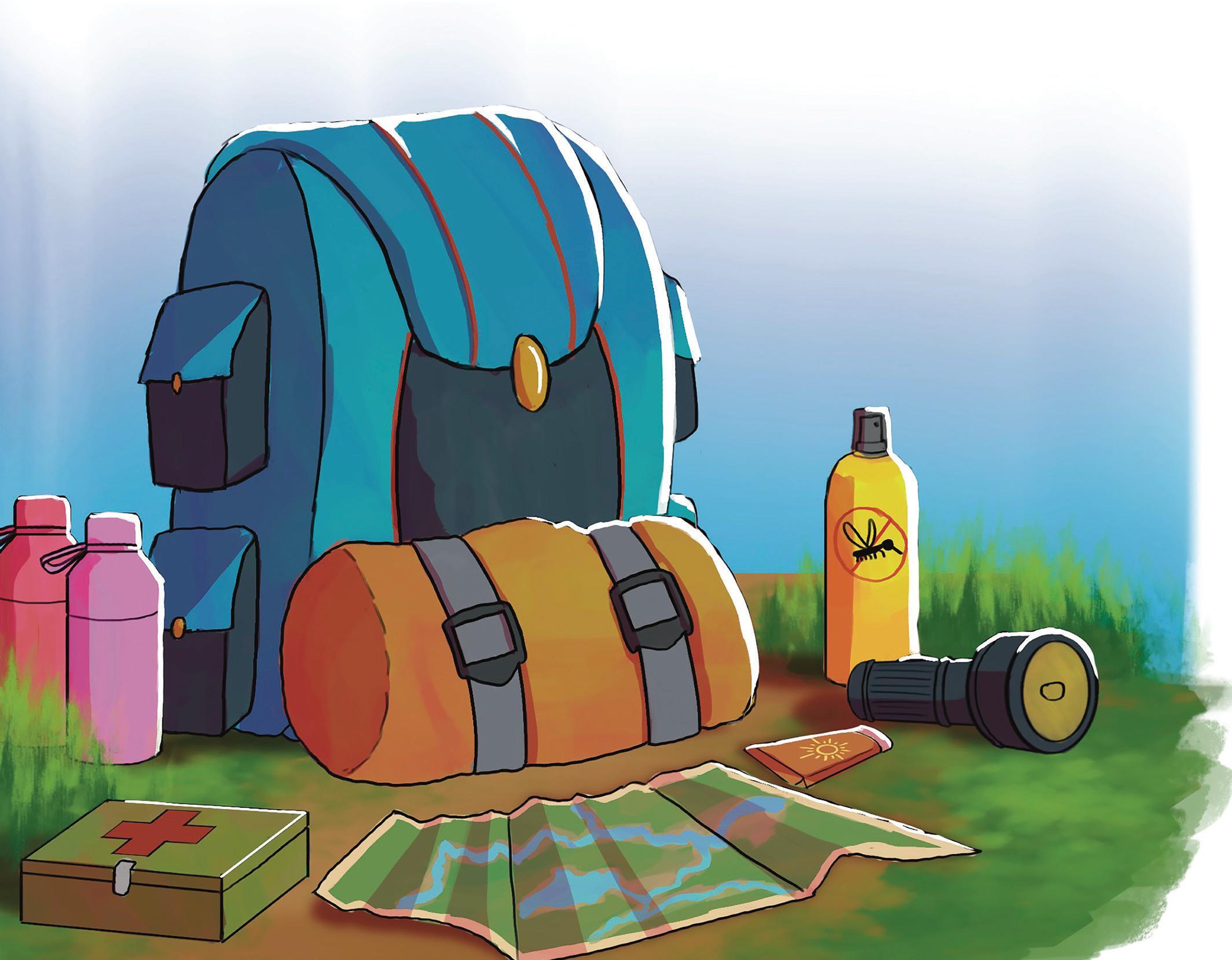
With five campgrounds and 52 sites in total, both Harrison West and Harrison East provide access to a long stretch of beach that offers opportunities for kayaking, canoeing, paddleboarding, fishing, hiking, and boating. Located along the shores of Harrison Lake, Twenty Mile Bay is about a twohour drive from Abbotsford. They are open from May 1 to Sept. 30 with rates of $18-25 a night for a single site and $36 for a double site, excluding reservation fees. I grew up camping with my aunt, uncle, and cousin so I appreciated that their large campsites allowed for the utmost tent space.
Manning Park, located in the core of the Cascade Mountains, is a must-stay campground. It is home to four campgrounds and over 450 sites plus another 10 for backcountry camping. Manning Park is versatile, staying open from May 17 to Oct. 14, with five summer campgrounds and three winter campgrounds. Rates vary based on the season and ground you choose from; summer camping costs between $25-75 per night and winter camping costs $13-53 per night — excluding long term stays. Having stayed at Lightning Lake, the most popular campground, I highly suggest it to anyone who is a fan of incredibly peaceful grounds and gorgeous viewpoints.
Cultus Lake is an ideal spot for campers coming from multiple areas who are looking for a super local location in the Fraser Valley. It’s one of the most popular locations to camp in B.C., partially due to its close proximity to the Cultus Lake village where jet ski, canoe, and boat rentals are available. They have four different campgrounds and 106 sites, all priced at a solid $35 per night. I thoroughly enjoyed staying at the Maple Bay campground. Tucked into the wilderness, it is close to some great hiking trails including the Teapot Hill hike and the Seven Sisters trail. They are just as convenient to access if you’re camping in Entrance Bay or Clear Creek, and are great for children, as you’re encouraged to look out for the seven enormous old-growth douglas fir along your path — you can’t miss them!
In my experience, May and June are prime times to camp. The camping season is just beginning and it’s the time of year where weather gets warmer but it’s not scorching (one can only hope), the bugs are not at an extremity yet, and the earth hasn’t dried up like a prune from no rain. If you camp in July, beware of the consequences. Excessive sweating, insect paranoia, and smoky air from wildfires are typical despite the seasonal campfire ban that’s usually implemented between March and October of each year.
There’s also the thousands of tourists who have the same idea to camp in B.C. I wouldn’t recommend camping in July or August. But if you do decide to brave it all and book a campsite, do it as early as possible. I also encourage any willing individuals to take up their own research. You may have to get your hands dirty and dig deeper, but there are many less-populated campgrounds that are worth a stay too. The Government of BC has their own reservation website to help you book sites in advance, and most campgrounds allow booking four months
“The wilderness must be explored!”
prior to visiting. Four months in advance is also exactly when you should start putting together that checklist of essential gear. Okay, maybe it’s not necessary at this stage, but you can never be too prepared.
As Russell the Wilderness Explorer from Up (2009) says, “the wilderness must be explored!” and to do that requires proper equipment. I mean, did you see the size of his backpack? There’s at least 10 essentials I believe make a smart camper and a successful trip, and I’m sure you would be rewarded with a wilderness preparedness badge from having them.
1. We all know technology isn’t always reliable, and nine times out of 10 there will be no cellular towers and therefore no wifi. Yes, you heard me. That’s why having a paper map, and knowing how to read it, is a useful navigation source and safety measure in the wilderness. I realize this is 2025 and no one has a paper map anymore besides my 86-year-old grandmother, but you’ll thank me later for investing in one when you end up lost and searching for service.
2. Flashlights are a necessity — specifically hands-free. You really don’t want to get to your campsite and realize you can’t see in the dark, especially during those midnight trips to the bathroom. They’re scary even with a flashlight, but it’s better than nothing.
3. Sunscreen is a no-brainer when you’re out in the elements.
4. Bug spray and mosquito coils — a standing spiral made from insecticides and plantbased material that burns to keep bugs away — are your friend. As your fellow paranoid camper, I know you don’t want to get bitten. Then you have to apply aloe vera, then you’re sticky, then you’re sweating at the same time … it’s a whole mess you just don’t want. Spray is useful when hiking, but coils can burn for multiple hours; placing them all around your campsite will keep more mosquitos away for longer periods of time.
5. You should always bring a basic first aid kit. Nature can be beautiful, but it can also
scrape, scratch, and scuff you. Ensure your kit is pre-stocked with bandages, Polysporin, Advil or Ibuprofen, and even aloe vera cream which is a natural healer and reliever for bites, wounds, and burns. Now, I’m no medical professional, but I am far too pale of an individual to not be well-versed in treating damage to my skin.
6. In a different fashion, a repair tool kit that includes duct tape, screwdrivers, knives, and scissors is handy. You would really be rocking the camper swag with a multi-tool since it’s small, compact, and an all-in-one.
7. Matches or lighters can be used for your own safety, both as an emergency signal if needed but also as a heat source when using a cooking stove. Since we aren’t cavemen and aren’t practiced in creating a spark from two rocks, it also works to light a contained CSA or ULC rated portable firepit, which can still be used during a fire ban. The bottom line? Please, for the love of mother nature and our lungs, be conscientious and don’t start a fire during a ban.
8. Summer air is usually drier and thicker regardless of whether wildfire smoke is present, so if there isn’t a potable water source around, bringing water bottles with you will keep you hydrated, especially when leaving your campsite for multiple hours.
9. Toilet paper may seem obvious, but it’s an item easily forgotten when going hiking — in my family, at least. I suppose you can always succumb to the leaves as a last resort or the crumpled tissue deep in your pocket … but just bring the toilet paper.
10. Lastly, insulated layers. If you’ve been in B.C. for even a year, you’ll know how unpredictable the weather is, so be prepared for any and all. Even if you’re camping in the summer, bring an extra jacket for the chill at night, pack a rain coat, rubber boots, closedtoed, durable runners, and a hard hat for hail … just in case.
Speaking of protecting yourself, bringing healthy snacks will prevent that hangry mood from creeping in for a while. Take it from someone who has been so hangry that I was scared of myself. These snacks have to be easy to make, easy to transport, and energizing for the road or hikes you might go on. Homemade granola bars were all time favourites in my family. They’re even more filling with nuts, and adding a little sweetness like cranberries brings them together. Popcorn is something fun that can easily be shared and is surprisingly
healthy, depending on how you prepare it. S’mores. Obviously. You cannot go camping without roasting marshmallows on the fire and making an ooey-gooey chocolate-y sandwich. Even if you don’t like s’mores, it’s the action of roasting and constructing them that might be just as satisfying as eating them. These are more of an end-of-day late night snack, but you can always bring a reusable container to carry them in.
Just as the s’mores’ marshmallows stretch when you eat them, camping is a flexible and non-restrictive summer activity. It has the freedom of spontaneity and little planning, especially with campsites closer to home since you might be more familiar with what’s around. It surely beats stressing over booking flights or configuring multiple excursions. No long plane ride equals driving through the layers of forest on an open road, shoes off, feet up, and feeling the breeze through your hair. The benefits of camping are both of mind and body, enhancing your mental, physical, and even financial well-being.
Nature is one of the best stress-reducing zones to unplug from the politics of the world, your job, or familial challenges. Nature is a self-regulator, and according to the Canadian Psychological Association, spending at least two hours per week outside and 20 minutes at a time is the most helpful for reducing stress hormones. We’ll find ourselves calmer with an increased mood and attention span, and it reduces our overall heart rate levels and therefore anxiety. To all my fellow student readers, I just gave you a psychological cure.
With technology being such a prominent aspect of our lives, it’s incredibly challenging to detach from the device and absorb what’s around you. Did you know time on a device contributes to exhaustion and insomnia? I know most of us have known insomnia before, and as students we are certainly familiar with sleep deprivation.
Fortunately, nature helps reset your circadian levels. That’s the official term for the cycle and rhythm your body experiences physically, mentally, and behaviourally over 24 hours. A study of the human circadian clock by Kenneth P. Wright involving an assessment on a group of healthy participants, found that just one week of camping was beneficial for participants’ sleep patterns.
“By subjecting their participants to one week of camping, free from light pollution and with more natural light during the day, the authors found that the onset and end of sleep in their participants entrained to the natural dawn and dusk.”
Your entire clock can be adjusted back to a normal schedule just by spending time in the great
outdoors. Alongside mental well-being, camping boosts our quality of life; the freedom of being outside creates plenty of opportunities to hike, swim, or bike. It may exhaust you, but the oxygenation and fresh air can improve cardiovascular function, and contribute to your overall health.
Being a camper encourages the slow-food lifestyle, meaning it decreases your consumption of fast food. You bring and make your own food, therefore saving money on eating out nearly every day like you might staying in a city. Plus, home-cooked meals are heartier and provide nutrients that are harder to obtain through processed foods. For all the rookie cooks out there, a pulled pork sandwich and potato salad is nothing complicated and will hit the spot again and again.
Sometimes campground areas have access to independently owned small businesses, and supporting them means that money isn’t going to big corporations, but rather right back into the community that is serving you. That’s right. We are out here being financially and economically healthy. Students can feel comfortable that camping is a low-impact trip on the wallet too. I’ll preface by saying that buying camping equipment can get pricey, but believe me when I say once you invest in supplies, you won’t have to invest again for a long time. Really, putting your funds toward a camping trip all together is hitting two birds with one stone. You’re saving money and you’re helping the planet.
The most valuable thing you can do while camping is practicing sustainability and maintaining a healthy ecosystem by leaving nothing but your footprints behind. Canadian-born environmental activist David Suzuki states the seven Leave No Trace principles, sharing how to enjoy your camping trip while also protecting mother nature.
1. Plan ahead and prepare
2. Travel and camp on durable surfaces
3. Dispose of waste properly
4. Leave what you find
5. Minimize campfire impacts
6. Respect wildlife
7. Be considerate of others
At this point, I’ve already shared ways you can prepare for your camping trip, but unless you’re off-trail camping, not altering the grounds you stay on is the most considerate thing you can do. On top of that, make use of your campsite’s recyclable and composting systems — leaving waste isn’t cool, but leaving the environment uninterrupted is. With B.C.’s record of wildfires as extensive as it is, be mindful of minimizing the exposure of cigarette butts and other flammable materials. Keep campfires small and in a designated area far from trees. The forest is the animals’ home too so if you have the chance to see one while out in nature, view from afar, don’t feed them, and keep control of your pets. Did you know camping can reduce our carbon footprint? We are temporarily living with less resources like electricity and water which
can reduce our energy usage. Using solar-powered lights and reusable containers (no glass!) will reap rewards for the earth long-term since you won’t be disposing of batteries or plastic.
Ultimately, camping is meant to be a fun way to escape the bustle of life and find peace in the wilderness, but you also want to make the safety of what’s around you a priority. Being mindful, resourceful, and knowledgeable will guide you through a smooth and enjoyable camping experience that prevents harm to our precious B.C. forests. I discussed real camping, but if you feel the same way that I did as a child, glamping or RVing might be more your thing. However, non-glamourous camping can be a way to submerge yourself in a world away from the things that make life challenging like politics, AI, maybe your job, or the fact that your phone charger won’t reach your bed. Camping in B.C. can feel like a home away from home, and from my perspective, that’s the best kind of vacation.


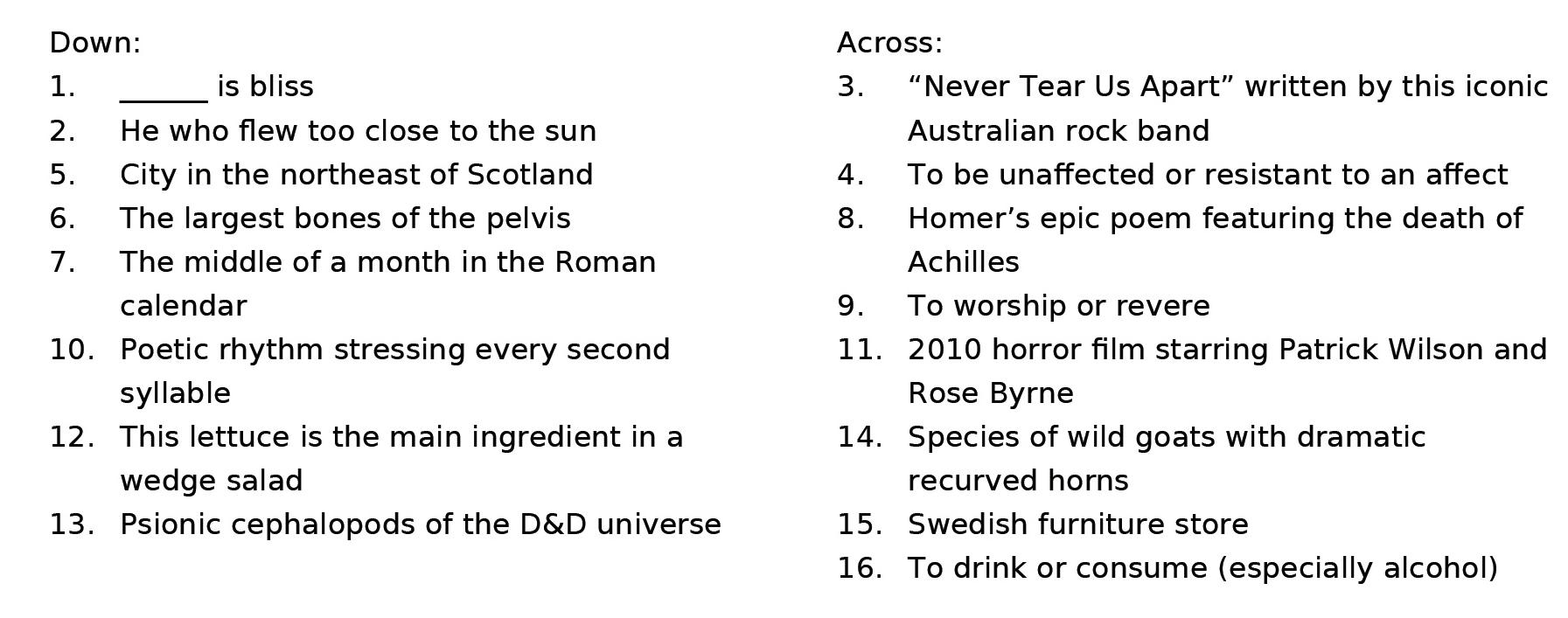



By: Madame LaCarte








Aries - Mar. 21 to Apr. 19
The semester has come to an end and although you made it to summer, you feel like the survivor of a shipwreck. It was a really tumultuous storm, and now you’re left on a raft floating to who-knows-where. If you find a volleyball, his name is Wilson.
Taurus - Apr. 20 to May 20
There is a right way to be right and a wrong way to be right. There is a kind way to be right and then there is what you do. Being a dick in the disguise of righteousness might be defensible as right, and yes maybe you’re not “wrong,” but you’re still a dick.
Gemini - May 21 to Jun. 20
You’ve been making steps to sieve through your generational trauma. You’re at that phase of the healing process where you are uncovering plenty of grit within your family you hadn’t seen before. There are a few more phases ahead, but eventually it will all refine.
Cancer - Jun. 21 to Jul. 22
Puzzles are puzzling. Sometimes the pieces just won’t fit together, sometimes the box with the image gets lost, and sometimes you just don’t know what you’re doing.
Leo - Jul. 23 to Aug. 22
Stop comparing your insides to others’ outsides. One, you’ll never match up, two, you can’t know what’s actually going on in their insides, and three, you’re not the best judge of yourself either.
Virgo - Aug. 23 to Sept. 22
OH MY GOD STOP! You are way too reactionary. You’re like an exposed nerve walking around, and when no one is around to poke you, you just start running toward sharp objects. Get a hobby. Give drama a break.
Libra - Sept. 23 to Oct. 22
If life was a game, you’re just playing it — not necessarily well, mind you, but respectably. Turn up the tunes, sit back, and play on.
Scorpio - Oct. 23 to Nov. 21
You don’t have to ride the garbage truck all the way to the dump. If you know where things are heading, maybe turn around before it starts to stink. I know, I know, if you start doing that then how will you ever be able to show others what a martyr you are. And, if they don’t pity you then how will you know that they care? Maybe get a dog or something … I don’t know.
Sagittarius - Nov. 22 to Dec. 21



So much to do, so much to see, but you’re stuck in a daydream fantasy. It’s better than your constant anxiety, but eventually you’ll need to deal with these insecurities.
Capricorn - Dec. 22 to Jan. 19
Honestly, lately, you’ve been giving crypto-bro. All this posturing and confidence talk, all the using of all the buzzwords, it’s not a good look on you. Try anything else.
Aquarius - Jan. 20 to Feb. 18
You’re a coin with two sides, or I guess a plate is more accurate. On one side are vegetables, a nice steak, a good sauce, maybe some mash or fries. On the other, it’s twinkies, nutella covered marshmallows, and fried chicken. This tendency for lack of consistency makes it hard for the cards to predict anything.
Pisces - Feb. 19 to Mar. 20

Fail, try, fail, try, fail again. Quitting gets a bad rep, but honestly, I’ve always found the bravest ones to be the ones who know when something is not working and simply adapt instead of stubbornly failing over and over again. Don’t be stubborn, try something else.
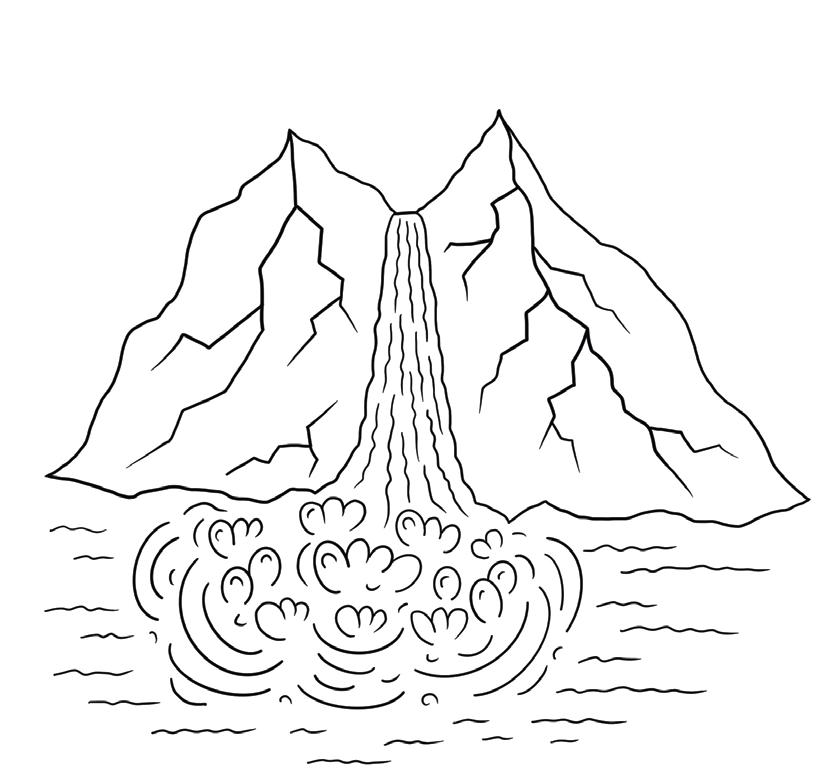
Looking at re-emerging trends from years gone by
This is Campus Fashion, your source of inspiration for seasonal trends, cool finds, and wardrobe basics to keep you looking stylish throughout the year. Fashion trends come and go, but some pieces have a knack for being reinvented and repopularized again and again. How does this happen? Influencers, fast fashion companies, and social media platforms are all contributing to bringing fashion trends in and out of style faster than ever before. The Cascade took a closer look at some of the ‘90s trends that are back in fashion again for this spring season.
Slip dresses
Reminiscent of silky slips worn under dresses in the ‘90s, this trend has made a comeback in 2025. Pair a blush pink slip dress with a nice white crew neck sweater and tall brown leather boots for a boho look. For a fun night out with friends, try wearing a navy version with a black leather jacket and heels.
Tie-up tops
As the name suggests, these shirts have a tie-up feature in the front and are fun to wear in bright or rich colours. They look great paired with dark wash jeans and colourful running shoes. For a more dressy look, wear a burgundy one with dark grey dress pants, a matching cardigan, and heels.
Plaid
Plaid shirts were another big trend in the ‘90s. Grungy and casual, plaid shirts look good with jeans, a white T-shirt, and white sneakers. Another way to sport this decades old trend is to pair brown plaid pants with a white sweater and brown leather loafers.
Overalls
This one-piece classic has made a comeback. Once reserved as a working man’s uniform, it later became a major fashion statement. For a ‘90s inspired outfit, try wearing an oversized pair of denim overalls with a graphic T-shirt and running shoes. For a more timeless look, wear a fitted pair of denim overalls with a plain, white, crew neck long sleeve shirt, a white
cardigan, a baseball cap, and white tennis shoes.
Flare jeans
These wider legged jeans are back with a bang this season. For a business casual look, try wearing a more fitted version with a light blue button-down shirt, a tweed blazer, and heels. For something more casual, pair an oversized hoodie and baggier fit flare jeans with a T-shirt and running shoes.
Biker shorts
A popular trend notably worn by celebrities like Princess Diana, these comfortable shorts are another staple of the ‘90s. Pair one with an oversized T-shirt and a sweatshirt worn around your shoulders for an effortless look.
And there you have it, six trends revamped from the past that are currently popular once more. Everything old is new again, as fashion, like history, has a way of repeating itself.

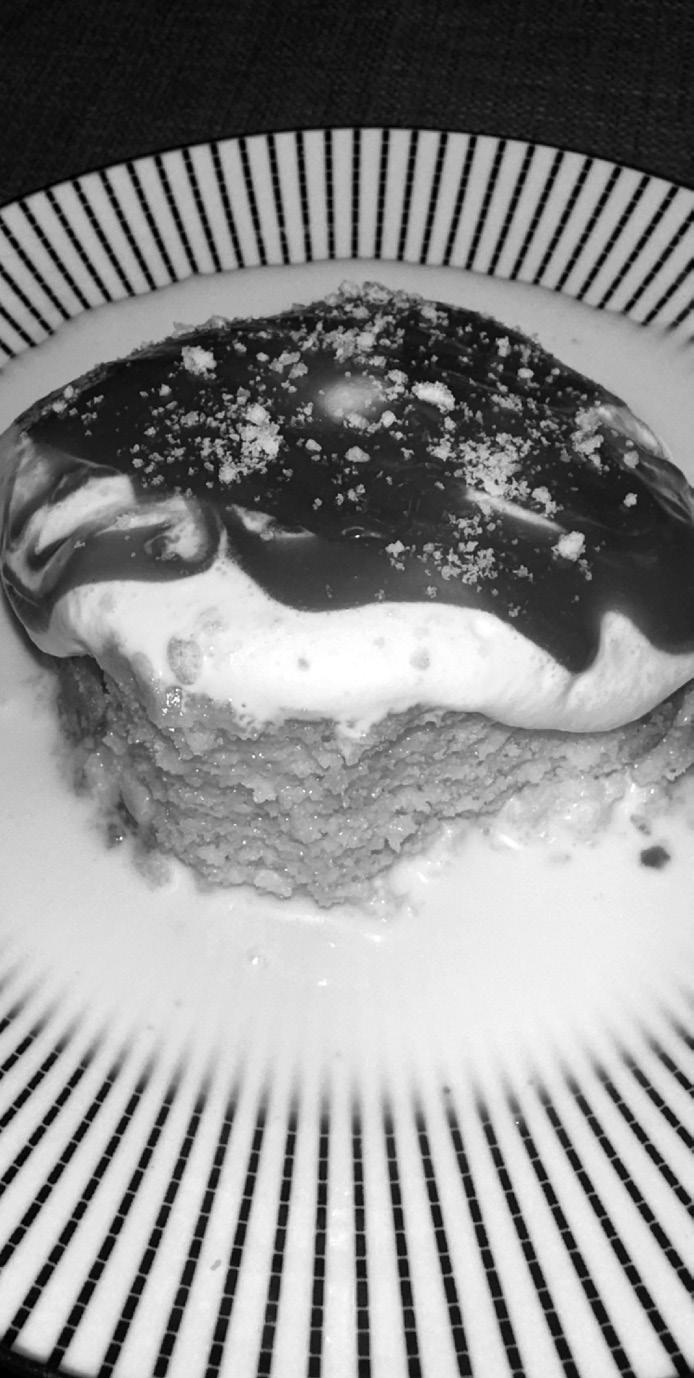
The Cascade Kitchen is a student-run food column that brings you budgetfriendly recipes and cooking tips. Check back each week for something new to try in the kitchen, or if you want to see your own recipe featured next, get started by reaching out to culture@ufvcascade.ca. Whether you’re feeling homesick, recovering from a break up, having a sleepover with friends, or it’s one of those random Tuesdays when the world feels too overwhelming, this Biscoff tres leches is the solution to all. This budget-friendly dessert is simple, cheap, doesn’t require anything fancy, and can be made even in a tiny dorm kitchen.
Ingredients
Cake:
1 box of golden or butter cake mix
3 eggs
1/2 cup butter
1 ¼ cup milk
Tres leches soak:
1/3 can of sweetened condensed milk
1/3 can of evaporated milk
1/3 cup 3% milk
1/2 tsp vanilla essence
Topping:
Whipped cream
Biscoff spread
Crushed Biscoff cookies (for garnish, if you’re feeling a little boujee)
Method
1. Preheat your oven to 350°F.
2. In a bowl, whisk together the whites of three eggs until they form soft peaks. Mix the rest of the wet cake ingredients in another bowl, including the egg yolks.
3. Now, combine the box mix with the wet ingredients and fold in the egg whites. Don’t over-mix — just enough to keep it airy. Then pour into a greased 8x8” pan and bake for 25-30 minutes, until the batter is golden and a skewer comes out clean from the middle.
4. Let the cake cool for 10-15 minutes. After that, take a fork or chopsticks and poke holes all over the cake — this
will help to soak in the milk mixture.
5. While waiting for the cake to cool, take a bowl and whisk together all three milks and the vanilla. Pour this slowly over the cake, making sure it soaks in evenly. Don’t rush it — tres leches is all about patience.
6. Let the dessert chill in the fridge for at least two hours.
7. Spread a layer of whipped cream all over the chilled cake. Use the back of a spoon or spatula to smooth it out like frosting.
8. Now, in a small pan or microwave-safe bowl, gently heat the Biscoff spread with a bit of milk. Stir until it becomes a pourable consistency, but not too runny.
9. Drizzle the Biscoff spread over the whipped cream and top it off with crumbled Biscoff cookies.
10. Your Biscoff tres leches is ready to serve!
CAITLYN CARR
A shining scarlet beacon in Abbotsford’s beautiful Mill Lake Park, the Kariton Art Gallery just concluded its most recent exhibition: Epilepsy in Full Colour. Spearheaded by the Centre for Epilepsy & Seizure Education in BC (C.E.S.E.B.C), the exhibit ran from Apr. 5 until its final day on Apr. 26.
The theme of the exhibit, Beyond Diagnosis, inspired work from a wide range of creators all over the province. Each canvas hung in the gallery highlighted an artist’s experience with either being diagnosed with epilepsy or caring for someone with the condition. Topics explored through the exhibit’s artwork
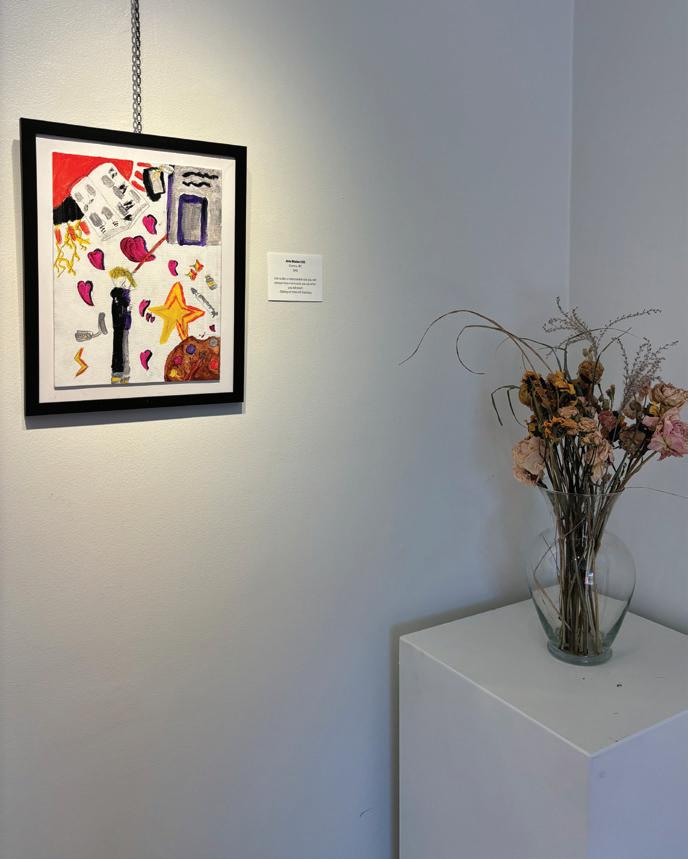
included medication, misdiagnosis, internal battles, outward appearances, and everyday challenges of the disorder.
Epilepsy is a neurological disorder which is diagnosed when an individual experiences a frequent number of repeated seizures. The centre’s online resource guide explains that seizures can come with a number of indicators.
“A seizure may consist of a brief stare, an unusual movement of the body, breathing difficulties, loss of bladder or bowel control, an odd sensation, a change in consciousness, or a convulsion (muscle contractions).”
Rupinder Bhatti, program manager at C.E.S.E.B.C. and a UFV alum, said that the centre’s intention for the exhibit was to shine a light on the lives of those impacted by epilepsy.
“We wanted people [with epilepsy] to really understand that they’re just as valuable as everybody else around them, and they have the same strength, if not more, and they can overcome anything. And that’s what we want to feature. We want people to feel like they belong, that they matter, and that their story matters.”
While most pieces incorporated some purple — the official colour representing epilepsy — many different colours were also seen in the gallery’s artwork. Bhatti said that the purpose of the exhibit’s title was to showcase the condition as a wide spectrum, since there are many different kinds of epilepsy.
When asked about some prevalent
misconceptions surrounding epilepsy, Bhatti described the one that she believes to be the most common.
“That’s one of the biggest misconceptions, [that] ‘it can’t happen to me.’... But like I said, anybody with a brain can have a seizure.”
Bhatti explained that the idea of an art exhibition came from the centre’s desire to raise awareness and eliminate the stigma surrounding epilepsy in a different way than they’d done previously.
“Instead of redoing what we do every year, which is normally a walk at Mill Lake Park … we were like, ‘hey, let’s switch it up this year and do something different.’”
If you or someone you know is struggling with epilepsy, Bhatti encourages paying a visit to the centre to see what kinds of support might be available for you.
Good skincare is more than just a routine; it’s a reflection of your daily habits, signalling how serious you take your well-being. Through my own skincare journey, I have gone from finding skincare a foreign concept to looking forward to it. I want you to feel the same, so let’s help you find your skin type, build a skincare regime, and debunk some common misconceptions.
With so much skincare advice available, it’s easy to get swept up and fall for misconceptions. One such myth: you must exfoliate daily for healthy, glowing skin. In reality, exfoliating your skin two to three times a week is enough. Too much can irritate and damage skin.
Another common myth claims that oily skin doesn’t need moisturizer. The truth is, skin oils and skin hydration are different. Skin oils are generated by sebaceous glands to protect your skin, but they don’t moisturize. No matter your skin type, be it oily or dry, it’s important to moisturize. There are also many false beliefs about sunscreen, such as not needing sunscreen indoors, that dark skin doesn’t need sunscreen at all, or that you only need one application a day. All of these are untrue! No matter the location of your body, skin colour, or skin type, you must put on sunscreen. When exposed to the sun, apply sunscreen every two hours for adequate protection.
The foundations of a skincare regime are the same for every skin type: cleansing,
“If [you] just need someone to talk to for a couple of minutes, [you] can drop by our office too … Our door is always open for everybody.”
Meghan Dahl, the gallery and events manager at the Kariton, spoke on the variety of artists in the exhibit. Since the gallery usually only displays art from within the Fraser Valley, Dahl explained that it was nice to be able to feature artists from all over British Columbia.
“Art is for everyone, and so at the Kariton, we really want to connect as many people [as possible] with art.”
And if you’re looking for something to do now that the semester’s over, Kariton Art Gallery will be partnering up with the Central Fraser Valley Graphic Guild for their next exhibit, starting on May 3. They are open from 11 a.m. — 3 p.m., Thursday through Saturday. Dahl encourages everyone to check out the gallery.
“We’re free. We’re right in the park, we have new things all the time, and we support local artists [taking] their first steps of their career.”

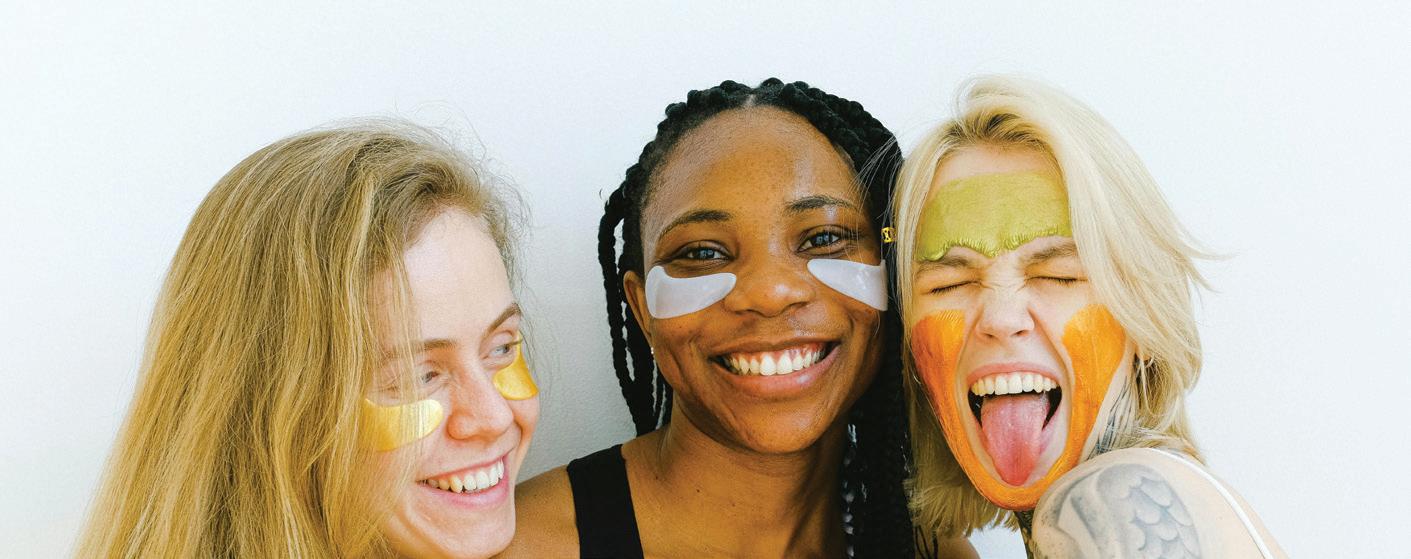
exfoliation, moisturizing, and sun protection. But before building a routine, it’s important to know your skin type, as this will determine the best products and methods for you. One of the easiest ways to do this is the “wait and watch method.” Wash your face with a mild cleanser, pat
it dry, and wait 30 minutes. If the skin on your face looks shiny all over, you likely have oily skin. If the shine is only around the T-zone (forehead, nose, and chin), you
VERONICA POWELL
The editorial board of UFV’s literary magazine, Louden Singletree, hosted a successful launch of their 2025 issue on Apr. 11, with many enthusiastic English department faculty and students in attendance to support.
In thinking about the previous launches I’ve attended, this year’s function was definitely a glow up. It included an abundant (free!) spread of sandwiches, fruit, sushi, cookies, and even a drink bar with alcoholic and non-alcoholic beverages. Located in Building K with plenty of space to mingle, it was a refreshing change compared to the tiny rooms of previous years. There was much to be impressed with.
The evening was guided by a comfortable, loosely-structured schedule that encouraged supporters to indulge in the food and drinks. Introductions were made for editorial board members, Kelsey Robson, Cassie Williams, Xavier Ibraheem, and Jorja Johns, before they discussed the making of the issue. Following that, a number of readers braved the stage to share their work aloud. In a heartwarming moment, Lydia Gunnink read her piece “Trying to Sing Palm
84,” followed by her boyfriend Gavin Thomas’s piece titled “Not Karaoke” which he had written about her.
An intermission followed, allowing time for light chatter and refills, but also a chance for guests to view the art pieces on display. There was also the opportunity to sign one of the cover posters — a new feature to the launch as part of the recognition of Professor Emeritus John Carroll’s work with the magazine, celebrating his retirement and his last issue as their faculty advisor. The evening rounded out with the final four readings and a congratulations to everyone involved, as well as a warm welcome to Professor Rob Taylor, the new advisor to head the production of Louden Singletree
The work featured in their 17th issue explored a variety of themes and topics such as the passing of time, memories of someone, identity, and trauma. The visual art was just as amazing as the written work including the exceptionally creative cover painted by MSAMI, titled “LONG. LIVE.$ELF.”
The Cascade took the opportunity to interview some speakers and hear their thoughts first hand after the end-of-launch mingling started and the nerves had settled.

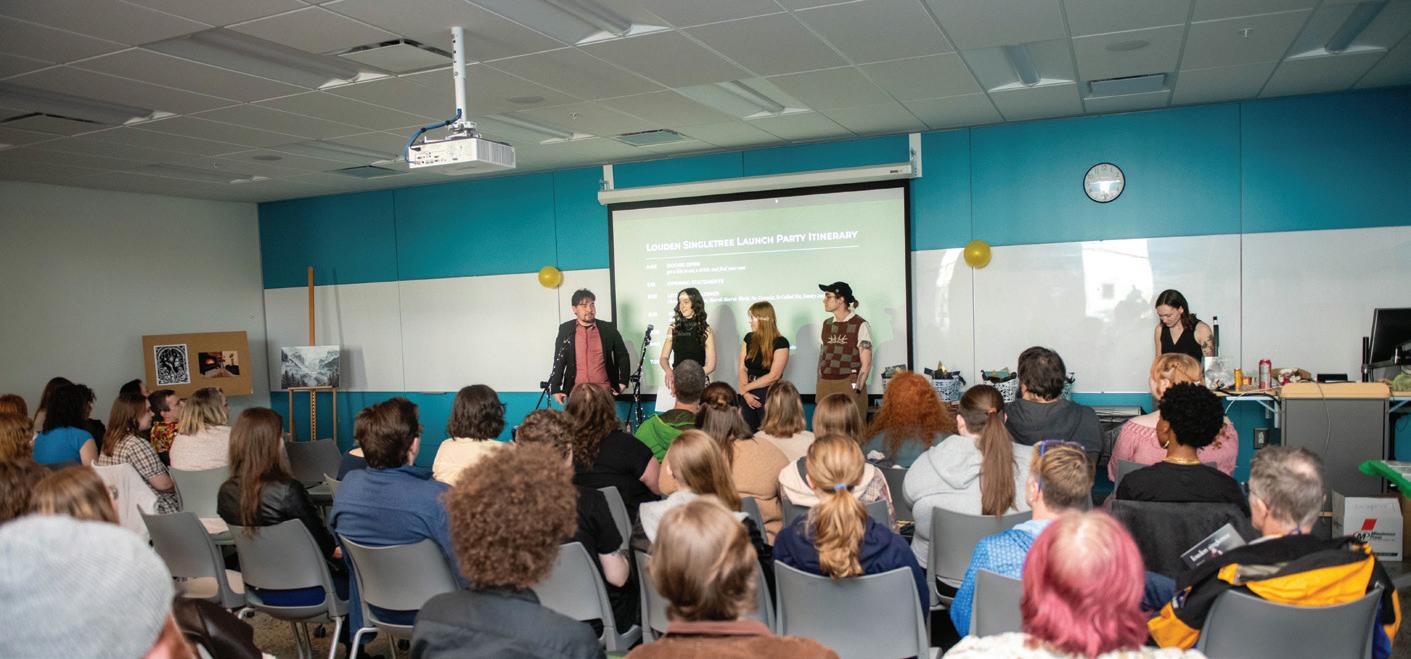
Caitlyn Harding had three pieces accepted this year: “If a Tree Falls,” “Mulberry Tree,” and “Gaelic Girls.” The first was a short poem, the second a longer poem inspired by Vincent Van Gogh’s painting “The Mulberry Tree,” and the third a short story.
“Being accepted once would have been cool, but the fact that all three of [my pieces] were was just really awesome. And I’m really grateful to be in this issue and be a further part of the community of Louden Singletree.”
Harding also reflected on the success of the launch event compared to previous years, expressing appreciation for the community
“I went to last year’s event as well, and we had a pretty good turnout last year, but I felt like there were even more people this year, which is just great, because it shows that the magazine is slowly gaining more people and followers. [It’s] really great to see that people in the community are participating with this magazine.”
Bryanne Lane read her piece “Creating Culture” which was a short, two page story prefaced and inspired by a quote from Remaa Menakem’s book,“My Grandmother’s Hands” in a chapter of the same name.
“I feel refreshed. It’s always really exciting to share your work with an audience and to see how people actually
receive it. With a lot of creative writing work, because it’s all written, it feels like you send it away and then never see it again. That’s why I love events like this, where you get to actually share it with people and talk to people about it.”
Kelsey Robson, Louden Singletree’s project manager, shared her perspective on the event, as well as a message to aspiring writers who have something to share.
“The turnout this year was amazing, and we have our launch party managers to thank for that. We did a lot of promoting, and [it] was better than we could [have hoped] for. It was beautiful.”
When asked how Louden Singletree can help a person looking to get their foot in the publishing door, Robson had insight to share.
“This is a really amazing opportunity for someone to get into the publishing process if you haven’t had anything published before. I’ve had professors say that the university is the first time they’ve had something published … even if you don’t get something submitted [the first time], try again [the] next year. The pieces were all so good [and] it’s not an easy decision.”
Copies of the Louden Singletree’s 2025 issue can be found in Rob Taylor’s office, room B378, and online at UFV’s website.

CONTINUED FROM PAGE 21
certainly wouldn’t know it. Was this a coming of age film for two late 40-yearold men? Quite possibly. But why? Last I checked, this game was not for late 40-year-olds.
There were a few interesting and creative moments, I enjoyed the aspects of building and creating (I need a tot launcher in my life). When I whispered to my brother next to me if what I was seeing on screen was actually how building works in the game, he whispered back “sort of.” So, I don’t really know what
that meant. Either way, half-heartedly mashing a bunch of crap together to try and make something kind of cool was pretty representative of the film itself. The all-star cast definitely made sense given the cult-like following Minecraft has, and I will never be unhappy with a Jennifer Coolidge appearance and Matt Berry cameo (even though their storyline was completely unrelated to the film and barely even ended).
Given that the last kids movie I saw in theatres was The Angry Birds Movie (2016) this was comparatively a masterpiece. But something happened to kids
movies; why aren’t they adult friendly anymore? Besides the really uncomfortable sexual innuendo between Steve (Jack Black) and Garrett (Jason Momoa), there were no easter eggs for adults. It was vastly unlike The Lego Movie (2014) or Shrek (2001) — where the characters are actually dynamic and likeable, and the jokes slap even for adults. And on another note, what’s with the sudden pop culture 80s trend I’ve been seeing in the last few years? I didn’t understand what year the movie was supposed to be set in. Minecraft is a modern game that I guess sort of looks like an 1980’s 8-bit game
Every time the summer rolls around I mournfully lay to rest my “sad boy playlist” in favour of whatever the new “brat summer” is — typically anything that I can blast in my car. This summer I don’t want to have to decide between the calming tones of Hozier or the catchy melodies of Sabrina Carpenter. With Djo’s third and newest album The Crux (2025) I don’t have to.
In 2016, I — like most of the world — watched Stranger Things (2016-2025) and immediately fell in love with Joe Keery through his portrayal of Steve Harrington. Years later I stumbled upon this artist Djo, through his song “Personal Lies.” Imagine my surprise when I discovered that Djo and the Stranger Things actor are one in the same. I watched the rest of the world make the same discovery when “End of Beginning” started trending on TikTok in 2022 — yes the guy that made that “Chicago” song is literally Steve Herrington.
In The Crux Keery combines his usual synthpop sound with classic rock to create this unique alt-pop style that gives perfect slow summer vibes — which after the hectic semester and world destructive politics, it’s more than needed. Each song in the album flows into the next, creating an easy listening experience while still bringing something distinct to the album. Some have a bouncier beat that remind me of the funk/soul band Vulfpeck, while others slow things down, creating moments for the songs to breathe within the album.
Probably the most popular song out of the entire album — “Charlie’s Garden” — feels the closest to that classic rock sound. Immediately in the first few seconds of the song The Beatles flooded my mind. The trumpets toward the end definitely didn’t help. Think “A Day in the Life” mixed with “Penny Lane” — add a little synth and that’s “Charlie’s Garden.”

The song has gained a lot of traction because it features Joe Keery’s Stranger Things co-star and good friend Charlie Heaton playing the role of a producer or casting director over the phone. An
obvious theme throughout The Crux is Keery spotlighting the people he loves, showing us just what the album is about for him.
“Back On You,” partly dedicated to his
such as Tetris, but most of these kids don’t even know what that is. The choice to go with an 80s aesthetic felt a lot like riding the coat-tails of current pop culture trends — which felt like a cheap way to grab viewers’ attention.
Long story short, there were a lot of questions whispered to my brother in the theatre, and while I struggled to pay attention to the messy plot line, he was thrilled at the end of it. As we walked out of the sticky, sugar-coated theatre (sorry, theatre staff) he gave it a roaring 10 out of 10, which, at the end of the day, is really all that matters.
sisters, is another clear example. With lyrics like “I’ve known my sisters for a lifetime / I count my lucky stars that I have them,” and “sisters made a better brother,” Keery shows his love for his siblings. As a sister, I will be sending this to my brothers.
“Charlie’s Garden” is only one of many nods to classic rock legends as “Back On You” opens with an ethereal chorus before a hard drum comes in with a whirling electric guitar — reminiscent of many Queen songs. Later in the song there’s mention of “Hello Mr. Blue Sky Blue,” alluding to the song “Mr. Blue Sky” by the Electric Light Orchestra. Also, in “Gap Tooth Smile,” Keery sings “Freddie said it right, ‘cause she’s my killer queen,” a clear reference to the Queen song “Killer Queen.” It’s easy to see where he drew inspiration from.
The entire album feels like a journey of self-discovery. While not sticking to one narrative, each song reveals more about the people Keery loves while simultaneously revealing more about himself. Especially in the song “Basic Being Basic” there’s clear commentary on this idea: “I don’t want your money, I don’t care for fame / I don’t wanna live a life where that’s my big exchange / I want simple pleasures, friends who have my back.” The song goes against the alt sound the rest of the album carries through its poppy chorus, creating dialogue between the lyrics and the melodies of the song itself. It’s a discordant message of trying to figure out who you are and learning what you’re not.
As a person in their 20s, I feel like that’s what life is for me right now: finding who I’m not and through that, who I am. Friends become sounding panels, sword sharpeners, and truth sayers. Keery brings us an authentic album at a time where the world cares about the unabashed truth. I don’t know about you, but for me this summer will be more contemplative, and this album provides the perfect soundtrack.
Creative Corner showcases original creative work from UFV students.
SEA WALL
We get off the SkyTrain as the sun is starting to set and the wind is picking up. It’s the same train and the same wind that — some months ago — daily swept my just-washed hair.
We walk to the house I used to live in, and I swear I still live there.
I ask you — you who is here for me — if there is anything left for me here.
Blocks from the Sea Wall on the shore, it’s settled. I belong nowhere. In this city I’m a ghost with a strange new form.
Molly and Ana are back in town for good. I’m not.
The wind is still biting as we meet them at our usual bar downtown. My last months away dissolve with each smoke break and beer downed.
The waitress at the Cambie cuts us off in the nicest way possible. None of us are shitfaced yet, though you do have a small frame and now we’re back on the train.
I put my feet up on the windowsill next to Ana’s, the reflections of our curls melt together as Science World disappears into a blanket of black weather.
Morning is rainy still, marked by an air mattress-induced soreness. We walk along the Sea Wall now, coins clink in a dirty cup, birds bathe on the rocks, and I can’t shut up.
“Walking here makes me sad,” I sigh past the parking lot for the yachts, a tangle of metal soaking in the bay.
“The ocean doesn’t make me sad” you reply but you misunderstand what I say.

Photo by Mnkn ada

By Aaron Levy
CIVL’s Aaron Levy received notice this week that the Canadian Radio-television and Telecommunications Commission (CRTC) decision for UFV’s Campus Community Radio Society’s application to broadcast permanently on 92.3 FM in Chilliwack — as per the saga documented in the recently teased film COUNTERCULTURE: 20 Years of CIVL Radio in the Fraser Valley, to be released widely in the next year — was approved. Holy moly.
Queen - “Radio Ga Ga” CIVL Board Member and Mission Folk Fest volunteer Cole Jodway sang this song at fellow Director and Townhall Abby (RIP) mainstay Balraj Singh’s request, so it was only appropriate to drop it like it’s hot off the top here. Fun fact: original filmmaker Jay Peachy liked this for a title.
The Flaming Lips - “Turn It On”
I’ve probably mentioned it here, but I’ll reiterate because it’s one of my favourite personal factoids — although I do like the song “Yoshimi Battles the Pink Robots,” I never dug The Flaming Lips at all until I heard this album, and I had seen them four times — once from stage — before then.
Kelly McMichael“Stepping Stone”
Name-dropping my university classmate/floormate, this song includes the line “Friends, they come and go” and when I “hear your song on the radio” I know I was “just a stepping stone for you.” The keys, changes, and songwriting on this one are classic level kick ass.
TV on the Radio - “Satellite”
If we built a studio in Chilliwack, it would essentially be our ‘satellite’ studio, based on the documentary where we do ‘TV’ on ‘the Radio’ station, get it? I think it makes perfect sense, so don’t rain on my parade, or pee on my shoes and tell me it’s raining.
01. SAYA GRAY
Saya 02. ART D’ECCO
Serene Demon 03. COOTIE CATCHER
Shy At First 04. YVES JARVIS
All Cylinders 05. NAYA ALI
We Did The Damn Thing
MEN I TRUST
Equus Asinus 07. JAPANESE BREAKFAST
For Melancholy Brunettes (& Sad Women) 08. DEVOURS
Sports Car Era 09. BASIA BULAT
Basia’s Palace 10. PIERRE KWENDERS
Tears On The Dance Floor
MARIE DAVIDSON
City of Clowns 12. SAMANTHA HOOEY Silver EP 13. DESTROYER
Dan’s Boogie 14. KASADOR
Kasador I 15. MOTHERHOOD
Thunder Perfect Mind 16. THE WEATHER STATION Humanhood 17. CHARLIE HOUSTON
Big After I Die 18. FROG EYES
The Open Up 19. SISTER RAY Believer 20. SKRILLEX
F*** U Skrillex You Think Ur Andy Warhol But Ur Not!!